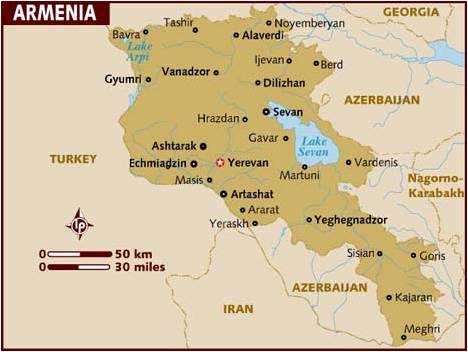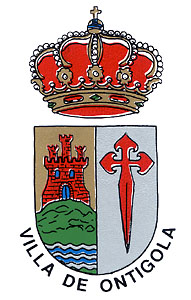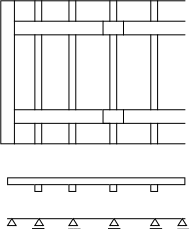PRI IN ARMENIA COUNTRY POPULATION1 2967975 (JULY 2011 EST)
102 REPUBLIC OF ARMENIA SECOND NATIONAL REPORT TO THE157 JOURNAL OF AZERBAIJANI STUDIES SPRING 1918 ARMENIAN TERRORISM
16 AN OVERVIEW OF EARLY ARMENIAN MONASTICISM ABRAHAM TERIAN
26 REVOLUTION OR EVOLUTION? THE ARMENIAN BOOK FROM MANUSCRIPT
54519 ARMENIA SOCIAL INVESTMENT FUND II PROJECT MIDTERM MISSION
AMENDED STATEMENT TO AARHUS CONVENTION COMPLIANCE COMMITTEE BY ARMENIAN

PRI in Armenia

Country Population1: 2,967,975 (July 2011 est.)
Prison Population: 4850
Prison Population rate: 149
% pre-trial detainees: 27.3%
% of women in Prison: 4.0 %
% of children: 2.6 %
Project Title: Promotion of Modern concepts in the administration of Juvenile Justice in Armenia
Donor: EIDHR
Key partners: Civil Society Institute (CIS) and Children’s Support Centre Foundation (FAR)
Duration: 36 months ( January 2011 – December 2013)
Background
Armenia acceded to the UN Convention on the rights of the child (CRC) in 1992. In 1996 it enacted the Rights of the Child Act and in 2003 a strategic programme for the reform of children’s institutions was approved, along with a National Programme of Action to Protect Children’s Rights (2004-2015). In 2004 the Ombudsman’s office was established. Armenia has submitted three periodic reports to the UN CRC Committee. The third and fourth consolidated report was submitted in February 2010 but the Committee has yet to submit its concluding observations. The State report is available here. In 2004 in its concluding observations the CRC Committee recommended that Armenia should provide support to local authorities and should involve civil society and NGOs in policy-making decisions which affect children’s rights. The CRC highlighted the absence of a system of juvenile justice including specific laws, procedures and juvenile courts. It noted the length of pre-trial detention, the limited access to visitors during this period; the disproportionate length of sentences in relation to the severity of offences; the conditions of detention and the absence of facilities for the physical and psychological recovery and the social reintegration of juvenile offenders. The committee recommended that the government of Armenia take account of the provisions of the CRC, in particular articles 37, 39 and 40, as well as other relevant international standards in this area (such as the Beijing Rules, the Riyadh Guidelines, the United Nations Rules for the Protection of Juveniles Deprived of their Liberty and the Vienna Guidelines for Action on Children in the Criminal Justice System).2
PRI’s project the ‘Promotion of Modern concepts in the administration of Juvenile Justice in Armenia’ will focus on diversion schemes, rehabilitation and psychosocial support for juveniles in detention and within the community. The project will promote legislative reform, build capacity and increase knowledge amongst key decision makers, the police, criminal courts, prison staff and local NGOs and civil society working with juvenile detainees. Special service centres for juveniles in conflict with law will be established and operated under the supervision of police and probation services. PRI together with partner organisations in Armenia, the Civil Society Institute (CIS) and Children’s Support Centre Foundation (FAR) will work with the Ombudsman to establish a system to monitor children’s institutions such as prisons and educational institutions.
Overall Objective
To contribute to the promotion and protection of the best interest of the child as well as the rights of the child in the juvenile justice system in Armenia. The project will focus on the wide engagement of the public in the diversion of juveniles from criminal justice system.
Specific objectives:
Raise awareness about children’s rights in general and promote legislative reform to ensure conformity of national legislation with international norms and standards concerning juvenile justice concepts in particular;
Promote the creation of a legal framework for the local application of international standards on juvenile justice;
Strengthen the role of civil society in the area of juvenile justice and carrying out pilot rehabilitation services for juveniles in conflict with law.
Activities include
At a practical level activities include rehabilitative, social and legal support; capacity building and training to assist in the development of a juvenile justice model; at a Country level PRI will work with governments to advocate and lobby for legislative amendments and raising awareness amongst key decision makers through trainings, conferences and events; and at a Global level PRI will lobby at the UN and CoE member states to encourage Armenia’s adherence to agreed new practices and legislative reform based on international standards.
The following activities will be implemented as part of the project:
Undertake an analysis of existing legislation and its compliance with international standards. Advise on necessary changes to conform to international norms and standards.
Capacity building of the key stakeholders (government and civil society).
Monitoring of court trials in juvenile cases and supporting the implementation of child rights in the criminal justice system.
Policy, advocacy and networking at a national and international level.
Engaging the Ombudsman and civil society in the monitoring of child institutions and places of detention.
Providing rehabilitation services in pilot schemes in two regions of Armenia.
Raising public awareness on child rights in general.
Expected Results
An expert group has provided expertise and recommendations for the development of a Juvenile Justice Scheme for Armenia including improved administrative function and the promotion of rights of the child policies.
Recommendations for improvements of the legislative framework for the protection of the right of the child within the juvenile justice have been developed and promoted. Key stakeholders including public officials, judges, prosecutors, lawyers, child protection units and community commissions are versed in all issues relating to juvenile justice and have gained report drafting skills for UN and other international mechanisms.
Protection of the rights of the child through the office of the ombudsman has been strengthened; Monitoring of the rights of the child in closed educational institutions and penitentiaries by civil society group has been carried out; special tools and procedures for monitoring the violation of the rights of the child has been developed in accordance with the UN OPCAT; trial monitoring of juvenile criminal cases has been conducted.
4. The Number of the children diverted from the criminal justice system has increased. Juvenile judges and probation officers have started using alternatives measures to imprisonment in juvenile cases including diversion schemes.
5. A practical model of rehabilitation has been trialed in two pilot regions of Armenia. Civil society’s role in the area of juvenile justice will be strengthened and various initiatives for reintegration of child offenders have been undertaken and implemented.
June 2011
1 CIA World Fact Book : https://www.cia.gov/library/publications/the-world-factbook/geos/am.html
2 The Committee considered the second periodic report of Armenia (CRC/C/93/Add.6) at its 924th and 925th meetings (see CRC/C/SR.924 and 925), held on 15 January 2004, and adopted, at its 946th meeting (CRC/C/SR.946), held on 30 January 2004, its concluding observations CRC/C/15/Add.225 dated 26 February 2004 are available at http://daccess-dds ny.un.org/doc/UNDOC/GEN/G04/405/45/PDF/G0440545.pdf?OpenElement ( last accessed 18 May 2011)
ARMENIA AZERBAIJAN AND GEORGIA CAUCASUS PROTECTED AREAS FUND (CPAF)1
ARMENIA EHEALTH FS PROJECT PREFACE ARMENIA EHEALTH FEASIBILITY STUDY
ARMENIA WTTPRS228 PAGE 55 VOTHER MEASURES AFFECTING INVESTMENT AND
Tags: (july 2011, (july, population1, armenia, 2967975, country
- INTRODUCTORY TRAINING IN APPLICATIONS OF GEOGRAPHIC INFORMATION SYSTEMS &
- MEMORIA RTVA 2015 ÍNDICE MEMORIA RTVA 2015 1 INTRODUCCIÓN…………………………………………………………………4
- MINISTÈRE DE LA CULTURE DEMANDE DE DÉCISION EN VERTU
- PROCEDURY POSTĘPOWANIA NAUCZYCIELI NIEPUBLICZNEGO LICEUM OGÓLNOKSZTAŁCĄCEGO SZKOŁY MISTRZOSTWA SPORTOWEGO
- KPA AMAN KONTRAS WALHI SP KIARA SPI API PUSAKA
- NEW PROVIDENCE SCHOOL DISTRICT NEW PROVIDENCE MIDDLE SCHOOL DRESS
- CENTER FOR CULTURAL AND TECHNICAL INTERCHANGE BETWEEN EAST AND
- Currículum Vitae de Jorge Enrique Haddad Datos Personales
- INTRODUCCIÓN ¿POR QUE ARGUMENTAR? ALGUNAS PERSONAS PIENSAN QUE ARGUMENTAR
- TROFEO REPSOL OPTIMIST LÁSER Y 420 CLUB NAUTICO
- SOLICITUD PARA (NOTA 1) DDÑA CON DNI Nº
- ANEXO I FORMULARIO PARA LA CONVOCATORIA DE SUBVENCIONES PARA
- OVERCOMING THE BARRIERS PROVIDING PHYSICAL ACCESS TO HISTORIC BUILDINGS
- ACUERDO QUE ESTABLECE LA CLASIFICACIÓN Y CODIFICACIÓN DE MERCANCÍAS
- ALMA MEMO NO 504 THE CLOUDSAT RADAR AND IMPLICATIONS
- ZUR EINFACHEN BEARBEITUNG BITTEN WIR SIE UNS DIE NACHSTEHENDEN
- ¿ QUÉ TIPO DE PERSONA QUEREMOS FORMAR ¿? EN
- HOTARAREA GUVERNULUI NR 1612 DIN 20 NOIEMBRIE 2006 PRIVIND
- EK4 ÖRNEK TC AFYON KOCATEPE ÜNİVERSİTESİ REKTÖRLÜK BİNASI ACİL
- CHROMATOGRAPHY OF PHOTOSYNTHETIC PIGMENTS STUDENTS’ SHEET INTRODUCTION THE
- 1 2 3 4 PROGRAMA DE LA ASIGNATURA “SEMINARIO
- REQUEST FOR PRODUCT CERTIFICATION IMPORTANT THIS FORM SHOULD BE
- LISTE DES ÉTABLISSEMENTS DE LA COMMUNAUTÉ FRANÇAISE NOM PRÉNOM
- ŽIVOTOPISNÁ POZNÁMKA NEELA WINKELMANN – HEYROVSKÁ NAR 1969 V
- RESOLUCIÓN DE 9 DE MARZO DE 2015 DE LA
- MINISTERIO DE SALUD CONSEJO NACIONAL DE SEGURIDAD SOCIAL EN
- 7 NO STEP PRIVATE PROPERTY ATTENTION! ELECTROMAGNETIC FIELD BASE
- SZAKMAI MEGÚJULÁS A SZENTESI KÖZOKTATÁSI INTÉZMÉNYEKBEN TÁMOP 31408220090029 JÁTÉKOS
- INTRODUCCIÓN EL USO DE SUPLEMENTOS DEPORTIVOS ESTÁ AMPLIAMENTE EXTENDIDO
- JUZGADO PRIMERA INSTANCIA Nº DE PROCEDIMIENTO JUICIO
INFRAESTRUCTURA CARRETERA EN LA REGIÓN SURSURESTE ARQ JORGE FERNÁNDEZ
 AYUNTAMIENTO DE ONTÍGOLA PZA CONSTITUCIÓN 1 45340 ONTÍGOLA BASES
AYUNTAMIENTO DE ONTÍGOLA PZA CONSTITUCIÓN 1 45340 ONTÍGOLA BASES I INFORMACION LEGAL DE LA EMPRESA AUTOGESTIONADA FECHA 1
I INFORMACION LEGAL DE LA EMPRESA AUTOGESTIONADA FECHA 1USDA FARM SERVICE AGENCY PROJECT RISK MANAGEMENT PLAN [TEMPLATE]
 PŘÍKLAD NÁVRHU ŽELEZOBETONOVÉ STROPNÍ KONSTRUKCE 1 PŘEDBĚŽNÝ NÁVRH TLOUŠŤKY
PŘÍKLAD NÁVRHU ŽELEZOBETONOVÉ STROPNÍ KONSTRUKCE 1 PŘEDBĚŽNÝ NÁVRH TLOUŠŤKY DATENBLATT EINER ERZEUGUNGSANLAGEEINES SPEICHERS 5 VON 5 E6 DATENBLATT
DATENBLATT EINER ERZEUGUNGSANLAGEEINES SPEICHERS 5 VON 5 E6 DATENBLATTINSPECTION OF EROSION CONTROL MEASURES DATE OF INSPECTION NAME
AGLOMERACIÓN URBANA DE LA COMARCA DE PAMPLONA MUNICIPIO SUPERFICIE
HUNGARIAN NATURAL HISTORY MUSEUM IKT SZÁM………………… 1088 BUDAPEST
Ðïࡱáþÿ ¥á Ø¿0ôvbjbjx97 x97 x8b Õ`ácõ`ác]x8aÿÿÿÿÿÿ·º º Ÿÿÿÿÿÿÿÿÿ8kô?lê²x8bêux8bx8bx8b±
RADICACIÓN NO 4 6 0 3 2 CASACIÓN CARLOS
HACETTEPE ÜNİVERSİTESİ EDEBİYAT FAKÜLTESİ BİLGİ VE BELGE YÖNTİMİ BÖLÜMÜ
TÍTULO “INTEGRACIÓN DE PERSONAS CON AUTISMO” PONENTE LIC ALBERTO
 MELBOURNE CITY COUNCIL ACTIVITIES LOCAL LAW 2019 INCLUDING CHANGES
MELBOURNE CITY COUNCIL ACTIVITIES LOCAL LAW 2019 INCLUDING CHANGESMONIKA CAŁKIEWICZ MODUS OPERANDI SPRAWCÓW ZABÓJSTW MONIKA CAŁKIEWICZ
SKYWARD GRADE BOOK “HOW TO” DOCUMENT YOU CANNOT
KRATAK SAŽETAK RADA MAGISTARSKI RAD POD NAZIVOM VIBROAKUSTIČNI MONITORING
GUIDELINES FOR COMPUTER AND NETWORK MAINTENANCE A DOS AND
 EXPLICACIONES SOBRE LOS SERVLETS DE LA APLICACIÓN WEB AGENDA
EXPLICACIONES SOBRE LOS SERVLETS DE LA APLICACIÓN WEB AGENDA P ROBLEMA 1 EN UN JARRÓN HAY 20
P ROBLEMA 1 EN UN JARRÓN HAY 20